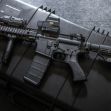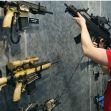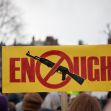In 1994, President Bill Clinton signed into law the Public Safety and Recreational Firearms Use Protection Act, which banned “semiautomatic assault weapons”- which were defined to include 18 different guns and all firearms with two or more “military characteristics.” Examples of “military characteristics” are bayonet mounts and flash suppressors. There was also a ban on detachable magazines that could accept more than 10 rounds at once. The ban had some pros and cons. However, whether you believe a part of the ban was a pro or a con depends on your views about gun control.
The assault weapons ban had many loopholes. A grandfather clause allowed for exemptions for guns and gun parts that were made before the assault weapons ban went into effect. There were no voluntary or mandatory buybacks for the 1.5 million firearms and 25 million magazines already in circulation that were a part of the ban. Gun manufacturers found ways to get around the ban by making small changes to the guns they already produced. For example, Marco Rubio said, “In New York, they have passed that ban. And you know what they’ve done to get around it?... They simply take the plastic tip off.”
The law was passed with a sunset provision that would automatically repeal the ban in ten years unless Congress voted to keep it in place. However, in 2004, George W. Bush, a Republican, was in office and Republicans had a majority in both the House and Senate, so Congress allowed the ban to lapse on September 13, 2004. Democrats have not been back in the majority until recently.
There were fewer mass shootings during the time of the assault weapons ban and the crime rate was down. However, the crime rate was already going down in the 1980s. Although, before the ban took effect, the number of mass shootings was not higher, even though crime was higher. The number of mass shootings actually increased at one point during the ban. There were 12 mass shootings between 1997 and 1999.
In 2019, before becoming president, Joe Biden wrote in a New York Times op-ed saying, “The 1994 assault weapons and high-capacity magazines bans worked. And if I’m elected president, we’re going to pass them again—and this time, we’ll make them even stronger.” Some proposals to make it stronger include buybacks of large-capacity magazines and firearms. Those in favor of voluntary buybacks on the campaign trail included Bernie Sanders, Elizabeth Warren, Kamala Harris, and Pete Buttigieg. Beto O’Rourke spoke in favor of mandatory buybacks after a mass shooting in El Paso, which is in the district he represented when he was in Congress. "I know this is not politically easy," he said. "Regardless of what it does to our prospects going forward, you've got to speak the truth and be clear about what the solutions are."
A study done in 2004 by the University of Pennsylvania looked at the effects of the assault weapons ban. It found that while the number of crimes including assault weapons decreased, crimes that involved high-capacity magazines did not decrease. According to Christopher Koper, the study’s main author, “[T]he ban’s exemption of millions of pre-ban [assault weapons] and [large-capacity magazines] ensured that the effects of the law would occur only gradually. These effects are still unfolding and may not be fully felt for several years into the future.”






